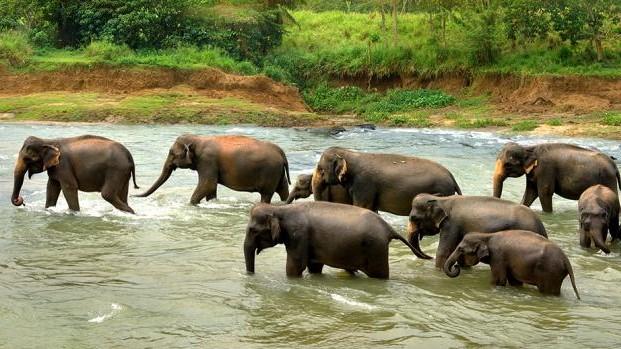World Elephant Day: Unsafe Future of Odisha’s Elephants

Image Courtesy: Down to Earth
New Delhi: As we celebrate the World Elephant Day on August 12, the distressed elephants of Odisha face an uncertain and dangerous future.
The safety of our national heritage animal in Odisha is in peril as the state has turned into a graveyard for elephants.
In the year 1979, there were 2,044 elephants in Odisha in the dense forests of Dhenkanal, Deogarh, Mayurbhanj, Keonjhar, Sambalpur, Angul, Sundargarh and Cuttack. Today, their number has reduced to 1976, last counted three years ago in 2017. But they have been forced to leave their native forests scattering into smaller populations and spreading out to several other districts. Notably, no census has been undertaken for the last three years in Odisha.
Odisha has lost more elephants than most elephant bearing Indians states. Meanwhile, elephant populations in some states are now twice that of Odisha.
Devastation of Elephant Landscape
The devastating changes in Odisha’s elephant landscape have virtually ruined the elephant habitats and traditional corridors, bringing them into frequent conflicts with humans. Keonjhar district, which had 112 elephants in 2002, had just 40 of them in 2017; it has lost the elephants to large-scale mining. On the other hand, the Dhenkanal district, which had 81 elephants in 2002, had 169 in 2017 as elephants had been trapped and could not cross to other forests on their traditional migration routes cut off by the Rengali irrigation canal network. Today, Dhenkanal witnesses more human-elephant conflict than any other district in Odisha.
The 60-odd elephants from the Chandaka sanctuary were so disturbed by development activities that they have now virtually abandoned the sanctuary and migrated to Ganjam and Cuttack districts. In fact, only one elephant was counted in Chandaka sanctuary during the 2017 census.
A group of 15 to 16 elephants from Chandaka, which had strayed into Ganjam’s Rambha forest range, has been completely wiped out owing to electrocutions, accidents and train accidents in the past four-five years. Another group of 15-16 elephants remains holed up in Ganjam’s Khallikote range, but their number has halved. Some Chandaka elephants of Khurda district have made inroads into Puri district where they were never seen in the past. This has resulted in the loss of human as well as elephant lives.
A larger group of about 25 Chandaka elephants that migrated to Cuttack district has now reduced to less than 20 and move around in small patches of forests in Athagarh and Khuntuni forest ranges in human-dominated landscapes.
Fourteen elephant corridors were officially identified by the Odisha government in January 2010, covering over 870 sq km, with the length being 420.8 km. These included three inter-state corridors shared with West Bengal, Chhattisgarh, and Jharkhand. Rs 20 crore were spent on the improvement of these corridors. However, these are not protected under the law.
Odisha had identified five elephant reserves out of which only three were notified: Mahanadi Reserve (8,036 sq. km), Mayurbhanj Reserve (7,043 sq. km), and Sambalpur Reserve (5,846 sq. km). The South Odisha Reserve (4,216 sq. km) and the Baitarani Reserve (10,516 sq. km) have not been notified yet. The delay in the notification can be ascribed to the intervention of the mining lobby, according to experts.
High Elephant Mortality Rates
The elephant mortality rate is rising alarmingly as the average death per year, which was 33 per year from 1990 to 2000, has increased to 46 per year between 2000 and 2010. Since 2010, the average has become 78 per year.
While 463 elephant deaths were recorded during the period between 2000 and 2010, the number grew sharply to 784 elephant deaths in the period 2010 to 2020. Of the 784 deaths in the last 10 years, 281 (36%) have been unnatural deaths and in 160 (20%) cases, the cause of death could not be ascertained primarily due to finding bodies in a highly decomposed state. One could conclude that nearly 50% of the elephant mortality in Odisha has unnatural causes.
Of the 784 elephant deaths in the last 10 years and four months, 114 were killed by poachers, primarily for Ivory, 79 were killed by poachers by laying live electric wires, 45 were killed due to negligence by Discoms leading to sagging electric supply lines and poorly fixed poles, 26 were killed by trains, six were killed on roads by speeding vehicles and 11 were killed in manmade structures like open wells and canals. The cause of death could not be ascertained in 160 deaths as 113 of them were found in highly decomposed state or just skeletal remains.
Electric wire trap poaching is a major cause of concern and many have been killed in Dhenkanal, Angul, Cuttack, and Keonjhar districts due to this dangerous threat. Inadequate patrols and lack of monitoring have led to the worsening of this crisis. Many forest areas have naked overhead 11KV and 33KV power lines which should be insulated to prevent hooking by poachers.
Dwindling Population of Adult Breeding Male Elephants
The Odisha elephant population now faces a grave threat as about 20 adult breeding male elephants die each year, mostly due to poaching and electrocution. Conservative figures put adult males including sub-adults at about 150-175, but the large adult breeding males above the age of 20 to 25 could be as less as 80 to 100. Mating by immature males will lead to the birth of more and more unhealthy calves resulting in higher mortality.
A dangerous trend of capturing wild tuskers who attack villagers and houses and keeping them inside zoos has also emerged. In January 2020, the Forest Department captured two tuskers from Jajpur and Angul districts. One of them died due to injuries while in captivity while the other languishes in Kapilash Zoo. Wildlife Society of Odisha has been demanding his release into the wild after radio-collaring him to track his movement.
According to Wildlife Society of Odisha Secretary Biswajit Mohanty, “Unless there are regular monitoring and fixing of accountability, the state’s elephants will continue to perish in such large numbers bringing ignominy to our state at national and international levels."
In Keonjhar, more than 12 unnatural deaths of elephants have been recorded in recent years.
Mohanty said the barbed wire fence has become a new threat as the Forest Department is now fencing hundreds of acres of dense forest habitat of elephants. This prevents easy elephant movement in Keonjhar, Angul, Dhenkanal, Sambalpur, and Sundargarh districts leading to serious conflict with local villagers.
Also read: Lessons from 2018 Floods: Flood-resistant Houses in Kerala Show Way Forward
Get the latest reports & analysis with people's perspective on Protests, movements & deep analytical videos, discussions of the current affairs in your Telegram app. Subscribe to NewsClick's Telegram channel & get Real-Time updates on stories, as they get published on our website.
























